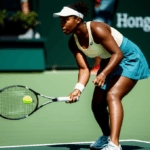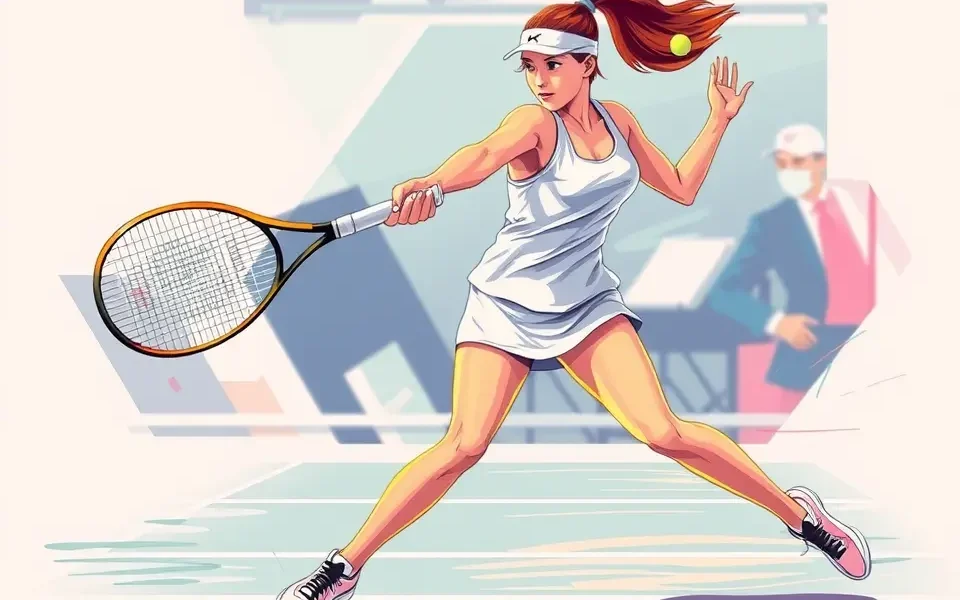Emma Raducanu burst onto the scene with her historic 2021 US Open victory, captivating the tennis world with her aggressive style and undeniable talent. While her backhand has often been lauded for its consistency and driving power, a closer look reveals an underrated weapon in her arsenal: her forehand. Often compared to Rafael Nadal’s relentless intensity and shot-making prowess, Raducanu’s forehand, when firing on all cylinders, showcases explosive potential and strategic brilliance. This analysis delves into the intricacies of Raducanu’s forehand technique, highlighting its strengths, areas for improvement, and its crucial role in her overall game.
The Kinetic Chain: Groundwork for Power
At the heart of any powerful tennis stroke lies the kinetic chain, a sequence of coordinated movements that transfer energy from the ground up through the body to the racket. Raducanu’s forehand is no exception, relying on efficient energy transfer to generate racket head speed and ball velocity.
Leg Drive and Weight Transfer
Like Nadal, Raducanu utilizes her legs extensively to generate power. A deep knee bend allows her to load the muscles in her legs, storing potential energy that is then released as she explodes upwards and into the ball. This “sit and lift” technique, similar to Nadal’s, helps her get under the ball and impart significant topspin. Weight transfer is also crucial, with Raducanu shifting her weight from her back leg to her front leg as she swings, further contributing to the shot’s power and momentum.
Core Rotation and Torso Engagement
The power generated from the legs is then transferred to the core, where trunk rotation plays a vital role. By coiling her upper body during the backswing, Raducanu stores elastic energy in her core muscles. As she initiates the forward swing, she explosively uncoils, rotating her hips and shoulders to generate racket head speed. This rotational power, combined with a stable and balanced base, allows her to hit the ball with considerable force.
Arm and Wrist Action: Lag and Acceleration
The final link in the kinetic chain involves the arm and wrist. Raducanu’s forehand exhibits a distinct racket lag, where the racket head trails behind her hand as she begins her forward swing. This lag creates a lever effect, increasing racket head speed at contact. As she approaches the ball, she unleashes a whiplike motion with her wrist, further accelerating the racket head and imparting spin. This combination of lag and wrist action allows her to generate both power and control.
Grip and Stance: Foundations of Technique
Raducanu’s forehand grip and stance are essential components that dictate her shot’s characteristics and versatility.
Semi-Western Grip: Topspin and Versatility
Raducanu employs a semi-western grip, a popular choice among modern players. This grip allows for a greater upward swing path, facilitating the generation of topspin. The semi-western grip also provides a good balance between power and control, enabling her to hit both aggressive shots and more defensive, spin-heavy balls.
Semi-Open Stance: Adaptability and Agility
Raducanu often utilizes a semi-open stance on her forehand, allowing her to maintain balance and agility while still generating power. This stance allows her to quickly adjust to different ball positions and effectively rotate her body into the shot. The semi-open stance also enables her to hit the ball on the rise, taking time away from her opponents.
Strategic Deployment: When and Where to Unleash the Forehand
The effectiveness of Raducanu’s forehand isn’t solely dependent on its technical execution; strategic deployment plays a vital role.
Attacking the Backhand
Like Nadal, Raducanu often uses her forehand to target her opponent’s backhand, particularly in cross-court rallies. This tactic allows her to exploit a potential weakness and dictate the flow of the match. By consistently applying pressure to the backhand, she can force errors or create opportunities to move her opponent out of position.
Changing Direction and Hitting Down the Line
While Raducanu frequently targets the backhand, she also demonstrates the ability to change direction and hit her forehand down the line. This shot, when executed effectively, can catch her opponents off guard and open up the court for further attacks. Her down-the-line forehand is a testament to her versatility and tactical awareness.
Forehand as an Approach Shot
Raducanu can also utilize her forehand as an effective approach shot, setting up opportunities to move forward and finish points at the net. A well-placed forehand approach can put pressure on her opponent, forcing them to hit a difficult passing shot or a weak reply, which she can then capitalize on with a volley or an overhead.
Areas for Improvement: Elevating the Forehand
Despite its strengths, Raducanu’s forehand can be further refined to unlock even greater potential.
Consistency
One area for improvement is consistency. While she is capable of hitting powerful and accurate forehands, she sometimes struggles to maintain that level of execution throughout an entire match. Reducing unforced errors and improving her overall consistency will be crucial for her continued success.
Forehand Placement
While Raducanu demonstrates good strategic awareness, further refinement of her forehand placement could significantly enhance its effectiveness. Developing the ability to consistently hit specific targets on the court, such as deep to the corners or short angles, will allow her to dictate play and exploit her opponent’s weaknesses more effectively.
Generating Racket Head Speed
Generating optimal racket head speed is key to maximizing power and spin. Raducanu can focus on fully utilizing the kinetic chain to unleash a faster, more explosive swing. Incorporating drills that emphasize core rotation, leg drive, and wrist action can help her generate greater racket head speed and enhance her forehand’s overall impact.
Comparison with Rafael Nadal: Inspiration and Adaptation
Comparisons between Raducanu’s forehand and Rafael Nadal’s are intriguing, as both players exhibit a similar intensity and commitment to generating power and spin. However, it’s important to note that their techniques are not identical, and Raducanu should focus on adapting Nadal’s principles to her own game, rather than simply imitating his style.
Similarities
- Leg Drive: Both players utilize their legs extensively to generate power and get under the ball.
- Core Rotation: Both Raducanu and Nadal rely on significant core rotation to generate racket head speed and ball velocity.
- Aggressive Mindset: Both players approach their forehands with an aggressive mindset, looking to dictate play and put pressure on their opponents.
Differences
- Grip: While both use grips that favor topspin, Nadal’s is more extreme.
- Swing Path: Nadal’s swing path is more loopy and exaggerated, which enhances his ability to generate extreme topspin.
- Physicality: Nadal’s game is built on incredible physicality and stamina, allowing him to maintain his intensity throughout long matches.
The Future of Raducanu’s Forehand
Emma Raducanu’s forehand is an evolving weapon with tremendous potential. By focusing on improving consistency, refining placement, and maximizing racket head speed, she can elevate her forehand to become an even more dominant force in her game. Drawing inspiration from players like Rafael Nadal, while also adapting their principles to her own unique style, will be crucial for her continued development. As she gains more experience and continues to refine her technique, Emma Raducanu’s forehand promises to be a key factor in her quest for future success on the WTA Tour.








No Comment! Be the first one.